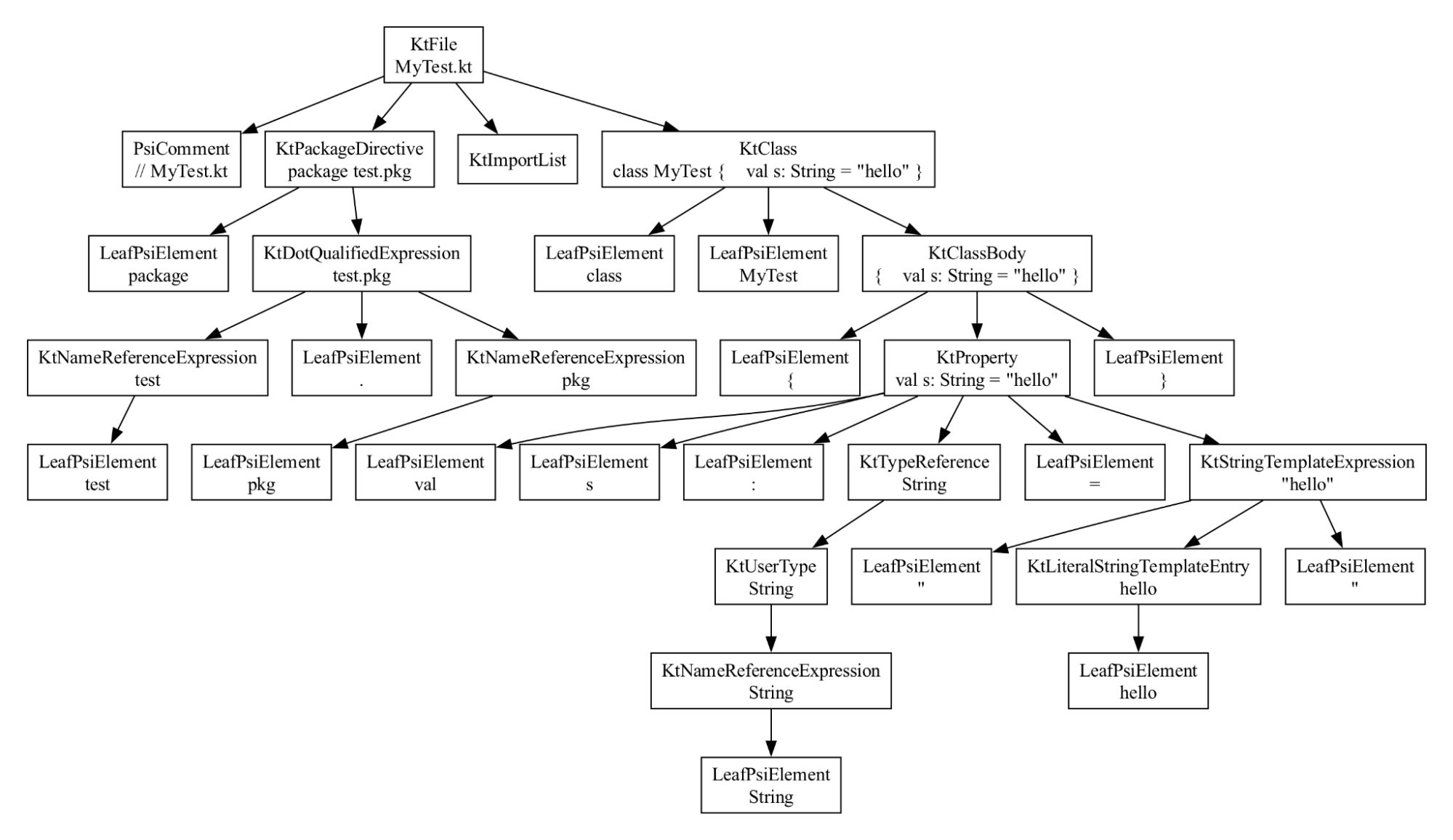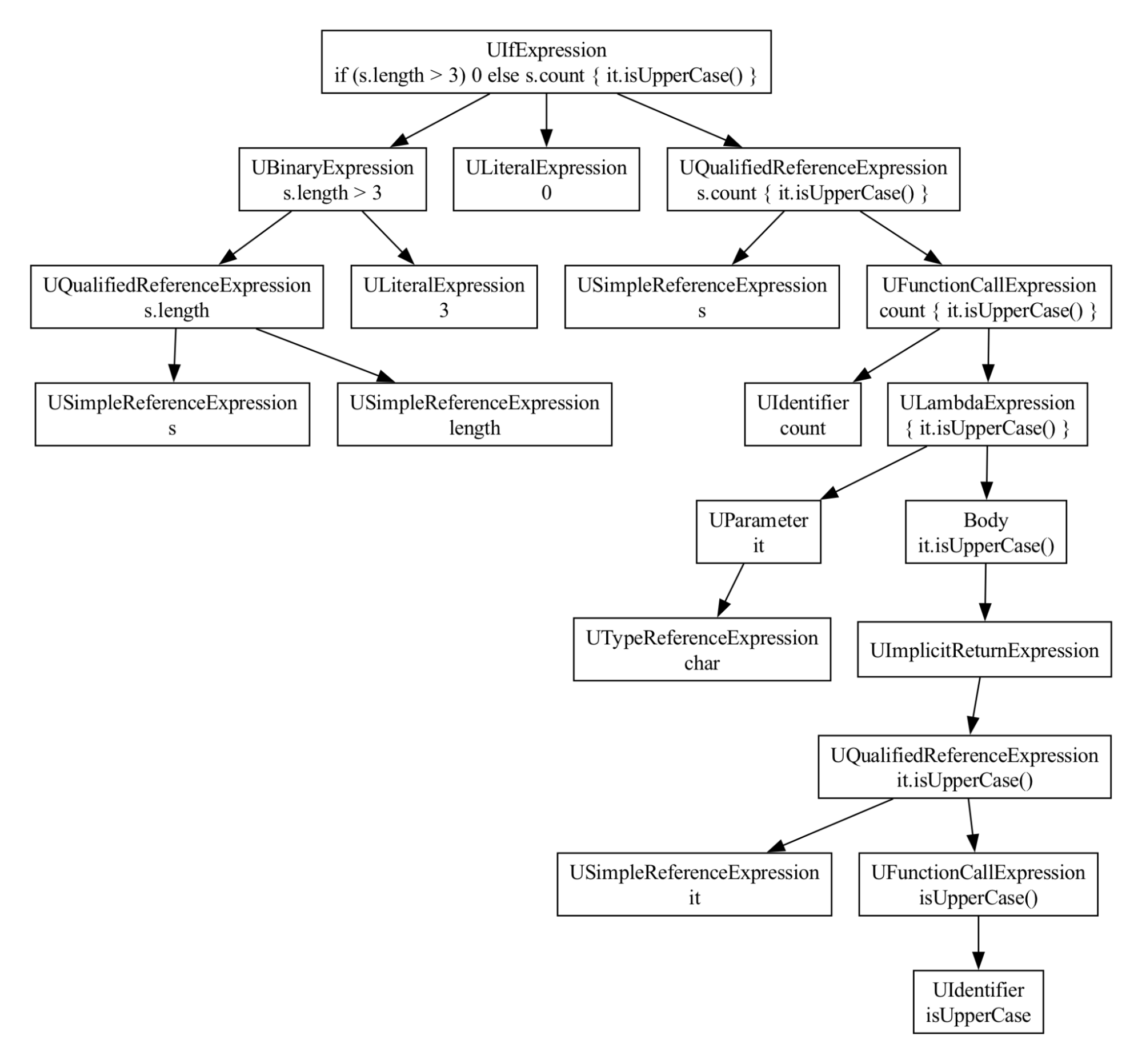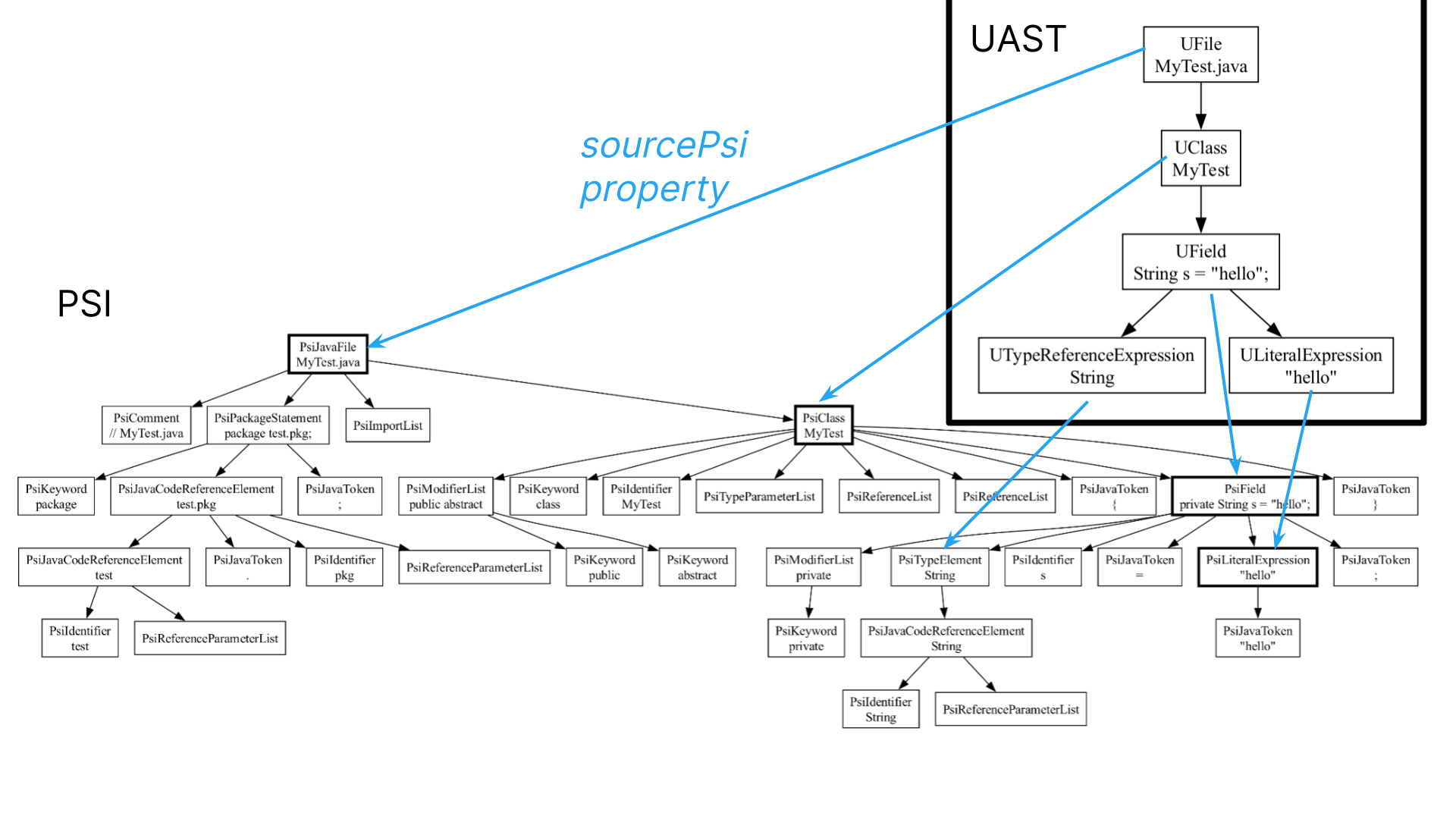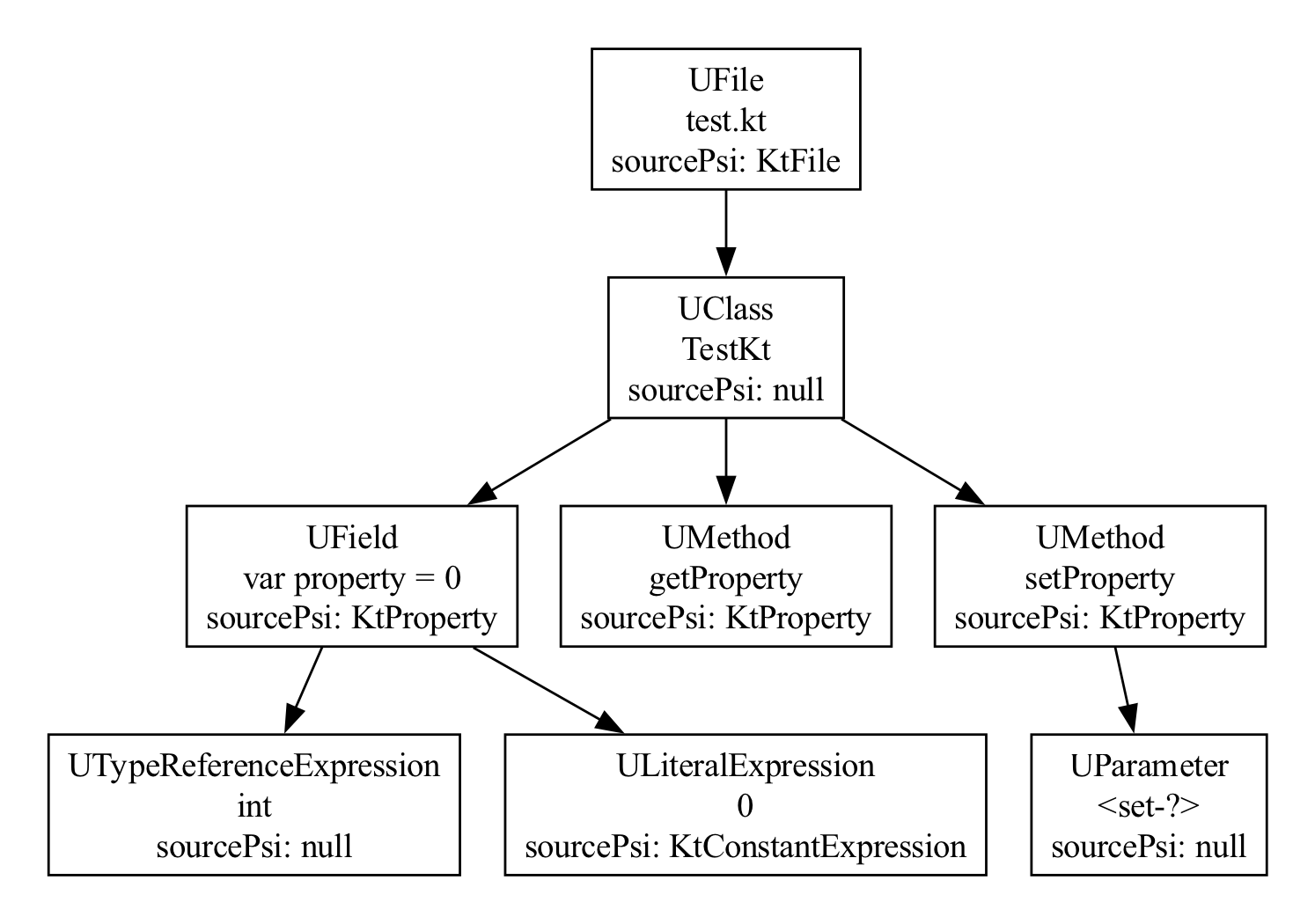# AST Analysis
To analyze Kotlin and Java files, lint offers many convenience callbacks
to make it simple to accomplish common tasks:
* Check calls to a particular method name
* Instantiating a particular class
* Extending a particular super class or interface
* Using a particular annotation, or calling an annotated method
And more. See the `SourceCodeScanner` interface for more information.
It also has various helpers, such as a `ConstantEvaluator` and a
`DataFlowAnalyzer` to help analyze code.
But in some cases, you'll need to dig in and analyze the “AST” yourself.
## AST Analysis
AST is short for “Abstract Syntax Tree” -- a tree representation of the
source code. Consider the following very simple Java program:
~~~~~~~~~~~~~~~~~~~~~~~~~~~~~~~~~~~~~~~~~~~~~~~~~~~~~~~~~~~~~~~~~java
// MyTest.java
package test.pkg;
public class MyTest {
String s = "hello";
}
~~~~~~~~~~~~~~~~~~~~~~~~~~~~~~~~~~~~~~~~~~~~~~~~~~~~~~~~~~~~~~~~~~~~~
Here's the AST for the above program, the way it's represented
internally in IntelliJ.

This is actually a simplified view; in reality, there are also
whitespace nodes tracking all the spans of whitespace characters between
these nodes.
Anyway, you can see there is quite a bit of detail here -- tracking
things like the keywords, the variables, references to for example the
package -- and higher level concepts like a class and a field, which I've
marked with a thicker border.
Here's the corresponding Kotlin program:
~~~~~~~~~~~~~~~~~~~~~~~~~~~~~~~~~~~~~~~~~~~~~~~~~~~~~~~~~~~~~~~kotlin
// MyTest.kt
package test.pkg
class MyTest {
val s: String = "hello"
}
~~~~~~~~~~~~~~~~~~~~~~~~~~~~~~~~~~~~~~~~~~~~~~~~~~~~~~~~~~~~~~~~~~~~~
And here's the corresponding AST in IntelliJ:

This program is equivalent to the Java one.
But notice that it has a completely different shape! They reference
different element classes, `PsiClass` versus `KtClass`, and on and on
all the way down.
But there's some commonality -- they each have a node for the file, for
the class, for the field, and for the initial value, the string.
## UAST
We can construct a new AST that represents the same concepts:

This is a unified AST, in something called “UAST”, short for Unified
Abstract Syntax Tree. UAST is the primary AST representation we use for
code in Lint. All the node classes here are prefixed with a capital U,
for UAST. And this is the UAST for the first Java file example above.
Here's the UAST for the corresponding Kotlin example:

As you can see, the ASTs are not always identical. For Strings, in
Kotlin, we often end up with an extra parent `UInjectionHost`. But for
our purposes, you can see that the ASTs are mostly the same, so if you
handle the Kotlin scenario, you'll handle the Java ones too.
## UAST: The Java View
Note that “Unified” in the name here is a bit misleading. From the name
you may assume that this is some sort of superset of the ASTs across
languages -- an AST that can represent everything needed by all
languages. But that's not the case! Instead, a better way to think of it
is as the **Java view** of the AST.
If you for example have the following Kotlin data class:
~~~~~~~~~~~~~~~~~~~~~~~~~~~~~~~~~~~~~~~~~~~~~~~~~~~~~~~~~~~~~~~kotlin
data class Person(
var id: String,
var name: String
)
~~~~~~~~~~~~~~~~~~~~~~~~~~~~~~~~~~~~~~~~~~~~~~~~~~~~~~~~~~~~~~~~~~~~~
This is a Kotlin data class with two properties. So you might expect
that UAST would have a way to represent these concepts. This should
be a `UDataClass` with two `UProperty` children, right?
But Java doesn't support properties. If you try to access a `Person`
instance from Java, you'll notice that it exposes a number of public
methods that you don't see there in the Kotlin code -- in addition to
`getId`, `setId`, `getName` and `setName`, there's also `component1` and
`component2` (for destructuring), and `copy`.
These methods are directly callable from Java, so they show up in UAST,
and your analysis can reason about them.
Consider another complete Kotlin source file, `test.kt`:
~~~~~~~~~~~~~~~~~~~~~~~~~~~~~~~~~~~~~~~~~~~~~~~~~~~~~~~~~~~~~~~kotlin
var property = 0
~~~~~~~~~~~~~~~~~~~~~~~~~~~~~~~~~~~~~~~~~~~~~~~~~~~~~~~~~~~~~~~~~~~~~
Here's the UAST representation:

Here we have a very simple Kotlin file -- for a single Kotlin property.
But notice at the UAST level, there's no such thing as top level methods
and properties. In Java, everything is a class, so `kotlinc` will create
a “facade class”, using the filename plus “Kt”. So we see our `TestKt`
class. And there are three members here. There's the getter and the
setter for this property, as `getProperty` and `setProperty`. And then
there is the private field itself, where the property is stored.
This all shows up in UAST. It's the Java view of the Kotlin code. This
may seem limiting, but in practice, for most lint checks, this is
actually what you want. This makes it easy to reason about calls to APIs
and so on.
## Expressions
You may be getting the impression that the UAST tree is very shallow and
only represents high level declarations, like files, classes, methods
and properties.
That's not the case. While it **does** skip low-level, language-specific
details things like whitespace nodes and individual keyword nodes, all
the various expression types are represented and can be reasoned about.
Take the following expression:
~~~~~~~~~~~~~~~~~~~~~~~~~~~~~~~~~~~~~~~~~~~~~~~~~~~~~~~~~~~~~~~kotlin
if (s.length > 3) 0 else s.count { it.isUpperCase() }
~~~~~~~~~~~~~~~~~~~~~~~~~~~~~~~~~~~~~~~~~~~~~~~~~~~~~~~~~~~~~~~~~~~~~
This maps to the following UAST tree:

As you can see it's modeling the if, the comparison, the lambda, and so
on.
## UElement
Every node in UAST is a subclass of a `UElement`. There's a parent
pointer, which is handy for navigating around in the AST.
The real skill you need for writing lint checks is understanding the
AST, and then doing pattern matching on it. And a simple trick for this
is to create the Kotlin or Java code you want, in a unit test, and then
in your detector, recursively print out the UAST as a tree.
Or in the debugger, anytime you have a `UElement`, you can call
`UElement.asRecursiveLogString` on it, evaluate and see what you find.
For example, for the following Kotlin code:
~~~~~~~~~~~~~~~~~~~~~~~~~~~~~~~~~~~~~~~~~~~~~~~~~~~~~~~~~~~~~~~kotlin
import java.util.Date
fun test() {
val warn1 = Date()
val ok = Date(0L)
}
~~~~~~~~~~~~~~~~~~~~~~~~~~~~~~~~~~~~~~~~~~~~~~~~~~~~~~~~~~~~~~~~~~~~~
here's the corresponding UAST `asRecursiveLogString` output:
~~~~~~~~~~~~~~~~~~~~~~~~~~~~~~~~~~~~~~~~~~~~~~~~~~~~~~~~~~~~~~~~~text
UFile (package = )
UImportStatement (isOnDemand = false)
UClass (name = JavaTest)
UMethod (name = test)
UBlockExpression
UDeclarationsExpression
ULocalVariable (name = warn1)
UCallExpression (kind = UastCallKind(name='constructor_call'), …
USimpleNameReferenceExpression (identifier = Date)
UDeclarationsExpression
ULocalVariable (name = ok)
UCallExpression (kind = UastCallKind(name='constructor_call'), …
USimpleNameReferenceExpression (identifier = Date)
ULiteralExpression (value = 0)
~~~~~~~~~~~~~~~~~~~~~~~~~~~~~~~~~~~~~~~~~~~~~~~~~~~~~~~~~~~~~~~~~~~~~
## Visiting
You generally shouldn't visit a source file on your own. Lint has a
special `UElementHandler` for that, which is used to ensure we don't
repeat visiting a source file thousands of times, one per detector.
But when you're doing local analysis, you sometimes need to visit a
subtree.
To do that, just extend `AbstractUastVisitor` and pass the visitor to
the `accept` method of the corresponding `UElement`.
~~~~~~~~~~~~~~~~~~~~~~~~~~~~~~~~~~~~~~~~~~~~~~~~~~~~~~~~~~~~~~~kotlin
method.accept(object : AbstractUastVisitor() {
override fun visitSimpleNameReferenceExpression(node: USimpleNameReferenceExpression): Boolean {
// your code here
return super.visitSimpleNameReferenceExpression(node)
}
})
~~~~~~~~~~~~~~~~~~~~~~~~~~~~~~~~~~~~~~~~~~~~~~~~~~~~~~~~~~~~~~~~~~~~~
In a visitor, you generally want to call `super` as shown above. You can
also `return true` if you've “seen enough” and can stop visiting the
remainder of the AST.
If you're visiting Java PSI elements, you use a
`JavaRecursiveElementVisitor`, and in Kotlin PSI, use a `KtTreeVisitor`.
## UElement to PSI Mapping
UAST is built on top of PSI, and each `UElement` has a `sourcePsi`
property (which may be null). This lets you map from the general UAST
node, down to the specific PSI elements.
Here's an illustration of that:

We have our UAST tree in the top right corner. And here's the Java PSI
AST behind the scenes. We can access the underlying PSI node for a
`UElement` by accessing the `sourcePsi` property. So when you do need to dip
into something language specific, that's trivial to do.
Note that in some cases, these references are null.
Most `UElement` nodes point back to the PSI AST - whether a Java
AST or a Kotlin AST. Here's the same AST, but with the **type** of the
`sourcePsi` property for each node added.

You can see that the facade class generated to contain the top level
functions has a null `sourcePsi`, because in the
Kotlin PSI, there is no real `KtClass` for a facade class. And for the
three members, the private field and the getter and the setter, they all
correspond to the exact same, single `KtProperty` instance, the single
node in the Kotlin PSI that these methods were generated from.
## PSI to UElement
In some cases, we can also map back to UAST from PSI elements, using the `toUElement` extension function.
For example, let's say we resolve a method call. This returns a
`PsiMethod`, not a `UMethod`. But we can get the corresponding `UMethod`
using the following:
~~~~~~~~~~~~~~~~~~~~~~~~~~~~~~~~~~~~~~~~~~~~~~~~~~~~~~~~~~~~~~~kotlin
val resolved = call.resolve() ?: return
val uDeclaration = resolve.toUElement()
~~~~~~~~~~~~~~~~~~~~~~~~~~~~~~~~~~~~~~~~~~~~~~~~~~~~~~~~~~~~~~~~~~~~~
Note however that `toUElement` may return null. For example, if you've
resolved to a method call that is compiled (which you can check using
`resolved is PsiCompiledElement`), UAST cannot convert it.
## UAST versus PSI
UAST is the preferred AST to use when you're writing lint checks for
Kotlin and Java. It lets you reason about things that are the same
across the languages. Declarations. Function calls. Super classes.
Assignments. If expressions. Return statements. And on and on.
There *are* lint checks that are language specific -- for example, if
you write a lint check that forbids the use of companion objects -- in
that case, there's no big advantage to using UAST over PSI; it's only
ever going to run on Kotlin code. (Note however that lint's APIs and
convenience callbacks are all targeting UAST, so it's easier to write
UAST lint checks even for the language-specific checks.)
The vast majority of lint checks however aren't language specific,
they're **API** or bug pattern specific. And if the API can be called
from Java, you want your lint check to not only flag problems in Kotlin,
but in Java code as well. You don't want to have to write the lint check
twice -- so if you use UAST, a single lint check can work for both. But
while you generally want to use UAST for your analysis (and lint's APIs
are generally oriented around UAST), there **are** cases where it's
appropriate to dip into PSI.
In particular, you should use PSI when you're doing something highly
language specific, and where the language details aren't exposed in UAST.
For example, let's say you need to determine if a `UClass` is a Kotlin
“companion object”. You could cheat and look at the class name to see if
it's “Companion”. But that's not quite right; in Kotlin you can
specify a custom companion object name, and of course users are free
to create classes named “Companion” that aren't companion objects:
~~~~~~~~~~~~~~~~~~~~~~~~~~~~~~~~~~~~~~~~~~~~~~~~~~~~~~~~~~~~~~~kotlin
class Test {
companion object MyName { // Companion object not named "Companion"!
}
object Companion { // Named "Companion" but not a companion object!
}
}
~~~~~~~~~~~~~~~~~~~~~~~~~~~~~~~~~~~~~~~~~~~~~~~~~~~~~~~~~~~~~~~~~~~~~
The right way to do this is using Kotlin PSI, via the
`UElement.sourcePsi` property:
~~~~~~~~~~~~~~~~~~~~~~~~~~~~~~~~~~~~~~~~~~~~~~~~~~~~~~~~~~~~~~~kotlin
// Skip companion objects
val source = node.sourcePsi
if (source is KtObjectDeclaration && source.isCompanion()) {
return
}
~~~~~~~~~~~~~~~~~~~~~~~~~~~~~~~~~~~~~~~~~~~~~~~~~~~~~~~~~~~~~~~~~~~~~
(To figure out how to write the above code, use a debugger on a test
case and look at the `UClass.sourcePsi` property; you'll discover that
it's some subclass of `KtObjectDeclaration`; look up its most general
super interface or class, and then use code completion to discover
available APIs, such as `isCompanion()`.)
## Kotlin Analysis API
Using Kotlin PSI was the state of the art for correctly analyzing Kotlin
code until recently. But when you look at the PSI, you'll discover that
some things are really hard to accomplish -- in particular, resolving
reference, and dealing with Kotlin types.
Lint doesn't actually give you access to everything you need if you want
to try to look up types in Kotlin PSI; you need something called the
“binding context”, which is not exposed anywhere! And this omission is
deliberate, because this is an implementation detail of the old
compiler. The future is K2; a complete rewrite of the compiler front
end, which is no longer using the old binding context. And as part of
the tooling support for K2, there's a new API called the “Kotlin
Analysis API” you can use to dig into details about Kotlin.
For most lint checks, you should just use UAST if you can. But when you
need to know really **detailed** Kotlin information, especially around
types, and smart casts, and null inference, and so on, the Kotlin
Analysis API is your best friend (and only option...)
!!! WARNING
The Kotlin Analysis API is not yet final and may continue to change.
In fact, most of the symbols have been renamed recently. For example,
the `KtAnalysisSession` returned by `analyze`, has been renamed
`KaSession`. Most APIs now have the prefix `Ka`.
### Nothing Type?
Here's a simple example:
~~~~~~~~~~~~~~~~~~~~~~~~~~~~~~~~~~~~~~~~~~~~~~~~~~~~~~~~~~~~~~~kotlin
fun testTodo() {
if (SDK_INT < 11) {
TODO() // never returns
}
val actionBar = getActionBar() // OK - SDK_INT must be >= 11 !
}
~~~~~~~~~~~~~~~~~~~~~~~~~~~~~~~~~~~~~~~~~~~~~~~~~~~~~~~~~~~~~~~~~~~~~
Here we have a scenario where we know that the TODO call will never
return, and lint can take advantage of that when analyzing the control
flow -- in particular, it should understand that after the TODO() call
there's no chance of fallthrough, so it can conclude that SDK_INT must
be at least 11 after the if block.
The way the Kotlin compiler can reason about this is that the `TODO`
method in the standard library has a return type of `Nothing`.
~~~~~~~~~~~~~~~~~~~~~~~~~~~~~~~~~~~~~~~~~~~~~~~~~~~~~~~~~~~~~~~kotlin
@kotlin.internal.InlineOnly
public inline fun TODO(): Nothing = throw NotImplementedError()
~~~~~~~~~~~~~~~~~~~~~~~~~~~~~~~~~~~~~~~~~~~~~~~~~~~~~~~~~~~~~~~~~~~~~
The `Nothing` return type means it will never return.
Before the Kotlin lint analysis API, lint didn't have a way to reason
about the `Nothing` type. UAST only returns Java types, which maps to
void. So instead, lint had an ugly hack that just hardcoded well known
names of methods that don't return:
~~~~~~~~~~~~~~~~~~~~~~~~~~~~~~~~~~~~~~~~~~~~~~~~~~~~~~~~~~~~~~~kotlin
if (nextStatement is UCallExpression) {
val methodName = nextStatement.methodName
if (methodName == "fail" || methodName == "error" || methodName == "TODO") {
return true
}
~~~~~~~~~~~~~~~~~~~~~~~~~~~~~~~~~~~~~~~~~~~~~~~~~~~~~~~~~~~~~~~~~~~~~
However, with the Kotlin analysis API, this is easy:
~~~~~~~~~~~~~~~~~~~~~~~~~~~~~~~~~~~~~~~~~~~~~~~~~~~kotlin linenumbers
fun callNeverReturns(call: UCallExpression): Boolean {
val sourcePsi = call.sourcePsi as? KtCallExpression ?: return false
analyze(sourcePsi) {
val callInfo = sourcePsi.resolveToCall() ?: return false
val returnType = callInfo.singleFunctionCallOrNull()?.symbol?.returnType
return returnType != null && returnType.isNothingType
}
}
~~~~~~~~~~~~~~~~~~~~~~~~~~~~~~~~~~~~~~~~~~~~~~~~~~~~~~~~~~~~~~~~~~~~~
Older APIs (pre-8.7.0-alpha04):
~~~~~~~~~~~~~~~~~~~~~~~~~~~~~~~~~~~~~~~~~~~~~~~~~~~kotlin linenumbers
/**
* Returns true if this [call] node calls a method known to never
* return, such as Kotlin's standard library method "error".
*/
fun callNeverReturns(call: UCallExpression): Boolean {
val sourcePsi = call.sourcePsi as? KtCallExpression ?: return false
analyze(sourcePsi) {
val callInfo = sourcePsi.resolveCall() ?: return false
val returnType = callInfo.singleFunctionCallOrNull()?.symbol?.returnType
return returnType != null && returnType.isNothing
}
}
~~~~~~~~~~~~~~~~~~~~~~~~~~~~~~~~~~~~~~~~~~~~~~~~~~~~~~~~~~~~~~~~~~~~~
The entry point to all Kotlin Analysis API usages is to call the
`analyze` method (see line 7) and pass in a Kotlin PSI element. This
creates an “analysis session”. **It's very important that you don't leak
objects from inside the session out of it** -- to avoid memory leaks and
other problems. If you do need to hold on to a symbol and compare later,
you can create a special symbol pointer.
Anyway, there's a huge number of extension methods that take an analysis
session as receiver, so inside the lambda on lines 7 to 13, there are
many new methods available.
Here, we have a `KtCallExpression`, and inside the `analyze` block we
can call `resolveCall()` on it to reach the called method's symbol.
Similarly, on a `KtDeclaration` (such as a named function or property) I
can call `.symbol` to get the symbol for that method or property, to
for example look up parameter information. And on a `KtExpression` (such
as an if statement) I can call `.expressionType` to get the Kotlin type.
`KaSymbol` and `KaType` are the basic primitives we're working with in
the Kotlin Analysis API. There are a number of subclasses of symbol,
such as `KaFileSymbol`, `KaFunctionSymbol`, `KaClassSymbol`, and
so on.
In the new implementation of `callNeverReturns`, we resolve the call,
look up the corresponding function, which of course is a `KaSymbol`
itself, and from that we get the return type, and then we can just check
if it's the `Nothing` type.
And this API works both with the old Kotlin compiler, used in lint right
now, and K2, which can be turned on via a flag and will soon be the
default (and may well be the default when you read this; we don't always
remember to update the documentation...)
### Compiled Metadata
Accessing Kotlin-specific knowledge not available via Kotlin PSI is one
use for the analysis API.
Another big advantage of the Kotlin analysis API is that it gives you
access to reason about compiled Kotlin code, in the same way that the
compiler does.
Normally, when you resolve with UAST, you just get a plain `PsiMethod`
back. For example, if we have a reference to
`kotlin.text.HexFormat.Companion`, and we resolve it in UAST, we get a
`PsiMethod` back. This is **not** a Kotlin PSI element, so our earlier
code to check if this is a companion object (`source is
KtObjectDeclaration && source.isCompanion()`) does not work -- the first
instance check fails. These compiled `PsiElement`s do not give us access
to any of the special Kotlin payload we can usually check on
`KtElement`s -- modifiers like `inline` or `infix`, default parameters,
and so on.
The analysis API handles this properly, even for compiled code. In fact,
the earlier implementation of checking for the `Nothing` type
demonstrated this, because the methods it's analyzing from the Kotlin
standard library (`error`, `TODO`, and so on), are all compiled classes
in the Kotlin standard library jar file!
Therefore, yes, we can use Kotlin PSI to check if a class is a companion
object if we actually have the source code for the class. But if we're
resolving a *reference* to a class, using the Kotlin analysis API is
better; it will work for both source and compiled:
~~~~~~~~~~~~~~~~~~~~~~~~~~~~~~~~~~~~~~~~~~~~~~~~~~~~~~~~~~~~~~~kotlin
symbol is KaClassSymbol && symbol.classKind == KaClassKind.COMPANION_OBJECT
~~~~~~~~~~~~~~~~~~~~~~~~~~~~~~~~~~~~~~~~~~~~~~~~~~~~~~~~~~~~~~~~~~~~~
Older APIs (pre-8.7.0-alpha04):
~~~~~~~~~~~~~~~~~~~~~~~~~~~~~~~~~~~~~~~~~~~~~~~~~~~~~~~~~~~~~~~kotlin
symbol is KtClassOrObjectSymbol && symbol.classKind == KtClassKind.COMPANION_OBJECT
~~~~~~~~~~~~~~~~~~~~~~~~~~~~~~~~~~~~~~~~~~~~~~~~~~~~~~~~~~~~~~~~~~~~~
#### Kotlin Analysis API Howto
When you're using K2 with lint, a lot of UAST's handling of resolve and
types in Kotlin is actually using the analysis API behind the scenes.
If you for example have a Kotlin PSI `KtThisExpression`, and you want to
understand how to resolve the `this` reference to another PSI element,
write the following Kotlin UAST code:
~~~~~~~~~~~~~~~~~~~~~~~~~~~~~~~~~~~~~~~~~~~~~~~~~~~~~~~~~~~~~~~kotlin
thisReference.toUElement()?.tryResolve()
~~~~~~~~~~~~~~~~~~~~~~~~~~~~~~~~~~~~~~~~~~~~~~~~~~~~~~~~~~~~~~~~~~~~~
You can now use a debugger to step into the `tryResolve` call, and
you'll eventually wind up in code using the Kotlin Analysis API to look
it up, and as it turns out, here's how:
~~~~~~~~~~~~~~~~~~~~~~~~~~~~~~~~~~~~~~~~~~~~~~~~~~~~~~~~~~~~~~~kotlin
analyze(expression) {
val reference = expression.getTargetLabel()?.mainReference
?: expression.instanceReference.mainReference
val psi = reference.resolveToSymbol()?.psi
…
}
~~~~~~~~~~~~~~~~~~~~~~~~~~~~~~~~~~~~~~~~~~~~~~~~~~~~~~~~~~~~~~~~~~~~~
### Configuring lint to use K2
To use K2 from a unit test, you can use the following lint test task override:
~~~~~~~~~~~~~~~~~~~~~~~~~~~~~~~~~~~~~~~~~~~~~~~~~~~~~~~~~~~~~~~kotlin
override fun lint(): TestLintTask {
return super.lint().configureOptions { flags -> flags.setUseK2Uast(true) }
}
~~~~~~~~~~~~~~~~~~~~~~~~~~~~~~~~~~~~~~~~~~~~~~~~~~~~~~~~~~~~~~~~~~~~~
Outside of tests, you can also set the `-Dlint.use.fir.uast=true` system property in your run configurations.
Note that at some point this flag may go away since we'll be switching
over to K2 completely.
## API Compatibility
Versions of lint before 8.7.0-alpha04 used an older version of the
analysis API. If your lint check is building against these older
versions, you need to use the older names and APIs, such as
`KtSymbol` and `KtType` instead of `KaSymbol` and `KaType`.
The analysis API isn't stable, and changed significantly between
these versions. The hope/plan is for the API to be stable soon, such
that you can start using the analysis API in lint checks and have it
work with future versions of lint.
For now, lint uses a special bytecode rewriter on the fly to try to
automatically migrate compiled lint checks using the older API, but
this doesn't handle all corner cases, so the best path forward is to
use the new APIs. In the below recipes, we're temporarily showing both
the new and the old versions.
## Recipes
Here are various other Kotlin Analysis scenarios and potential solutions:
### Resolve a function call
~~~~~~~~~~~~~~~~~~~~~~~~~~~~~~~~~~~~~~~~~~~~~~~~~~~~~~~~~~~~~~~kotlin
val call: KtCallExpression
…
analyze(call) {
val callInfo = call.resolveToCall() ?: return null
val symbol: KaFunctionSymbol? = callInfo.singleFunctionCallOrNull()?.symbol
?: callInfo.singleConstructorCallOrNull()?.symbol
?: callInfo.singleCallOrNull()?.symbol
…
}
~~~~~~~~~~~~~~~~~~~~~~~~~~~~~~~~~~~~~~~~~~~~~~~~~~~~~~~~~~~~~~~~~~~~~
Older APIs (pre-8.7.0-alpha04):
~~~~~~~~~~~~~~~~~~~~~~~~~~~~~~~~~~~~~~~~~~~~~~~~~~~~~~~~~~~~~~~kotlin
val call: KtCallExpression
…
analyze(call) {
val callInfo = call.resolveCall()
if (callInfo != null) {
val symbol: KtFunctionLikeSymbol = callInfo.singleFunctionCallOrNull()?.symbol
?: callInfo.singleConstructorCallOrNull()?.symbol
?: callInfo.singleCallOrNull()?.symbol
…
}
~~~~~~~~~~~~~~~~~~~~~~~~~~~~~~~~~~~~~~~~~~~~~~~~~~~~~~~~~~~~~~~~~~~~~
### Resolve a variable reference
Also use `resolveCall`, though it's not really a call:
~~~~~~~~~~~~~~~~~~~~~~~~~~~~~~~~~~~~~~~~~~~~~~~~~~~~~~~~~~~~~~~kotlin
val expression: KtNameReferenceExpression
…
analyze(expression) {
val symbol: KaVariableSymbol? = expression.resolveToCall()?.singleVariableAccessCall()?.symbol
}
~~~~~~~~~~~~~~~~~~~~~~~~~~~~~~~~~~~~~~~~~~~~~~~~~~~~~~~~~~~~~~~~~~~~~
Older APIs (pre-8.7.0-alpha04):
~~~~~~~~~~~~~~~~~~~~~~~~~~~~~~~~~~~~~~~~~~~~~~~~~~~~~~~~~~~~~~~kotlin
val expression: KtNameReferenceExpression
…
analyze(expression) {
val symbol: KtVariableLikeSymbol = expression.resolveCall()?.singleVariableAccessCall()?.symbol
}
~~~~~~~~~~~~~~~~~~~~~~~~~~~~~~~~~~~~~~~~~~~~~~~~~~~~~~~~~~~~~~~~~~~~~
### Get the containing class of a symbol
~~~~~~~~~~~~~~~~~~~~~~~~~~~~~~~~~~~~~~~~~~~~~~~~~~~~~~~~~~~~~~~kotlin
val containingSymbol = symbol.containingSymbol
if (containingSymbol is KaNamedClassSymbol) {
…
}
~~~~~~~~~~~~~~~~~~~~~~~~~~~~~~~~~~~~~~~~~~~~~~~~~~~~~~~~~~~~~~~~~~~~~
Older APIs (pre-8.7.0-alpha04):
~~~~~~~~~~~~~~~~~~~~~~~~~~~~~~~~~~~~~~~~~~~~~~~~~~~~~~~~~~~~~~~kotlin
val containingSymbol = symbol.getContainingSymbol()
if (containingSymbol is KtNamedClassOrObjectSymbol) {
…
}
~~~~~~~~~~~~~~~~~~~~~~~~~~~~~~~~~~~~~~~~~~~~~~~~~~~~~~~~~~~~~~~~~~~~~
### Get the fully qualified name of a class
~~~~~~~~~~~~~~~~~~~~~~~~~~~~~~~~~~~~~~~~~~~~~~~~~~~~~~~~~~~~~~~kotlin
val containing = declarationSymbol.containingSymbol
if (containing is KaClassSymbol) {
val fqn = containing.classId?.asSingleFqName()
…
}
~~~~~~~~~~~~~~~~~~~~~~~~~~~~~~~~~~~~~~~~~~~~~~~~~~~~~~~~~~~~~~~~~~~~~
Older APIs (pre-8.7.0-alpha04):
~~~~~~~~~~~~~~~~~~~~~~~~~~~~~~~~~~~~~~~~~~~~~~~~~~~~~~~~~~~~~~~kotlin
val containing = declarationSymbol.getContainingSymbol()
if (containing is KtClassOrObjectSymbol) {
val fqn = containing.classIdIfNonLocal?.asSingleFqName()
…
}
~~~~~~~~~~~~~~~~~~~~~~~~~~~~~~~~~~~~~~~~~~~~~~~~~~~~~~~~~~~~~~~~~~~~~
### Look up the deprecation status of a symbol
~~~~~~~~~~~~~~~~~~~~~~~~~~~~~~~~~~~~~~~~~~~~~~~~~~~~~~~~~~~~~~~kotlin
if (symbol is KaDeclarationSymbol) {
symbol.deprecationStatus?.let { … }
}
~~~~~~~~~~~~~~~~~~~~~~~~~~~~~~~~~~~~~~~~~~~~~~~~~~~~~~~~~~~~~~~~~~~~~
Older APIs (pre-8.7.0-alpha04):
~~~~~~~~~~~~~~~~~~~~~~~~~~~~~~~~~~~~~~~~~~~~~~~~~~~~~~~~~~~~~~~kotlin
if (symbol is KtDeclarationSymbol) {
symbol.deprecationStatus?.let { … }
}
~~~~~~~~~~~~~~~~~~~~~~~~~~~~~~~~~~~~~~~~~~~~~~~~~~~~~~~~~~~~~~~~~~~~~
### Look up visibility
~~~~~~~~~~~~~~~~~~~~~~~~~~~~~~~~~~~~~~~~~~~~~~~~~~~~~~~~~~~~~~~kotlin
if (symbol is KaDeclarationSymbol) {
if (!isPublicApi(symbol)) {
…
}
}
~~~~~~~~~~~~~~~~~~~~~~~~~~~~~~~~~~~~~~~~~~~~~~~~~~~~~~~~~~~~~~~~~~~~~
Older APIs (pre-8.7.0-alpha04):
~~~~~~~~~~~~~~~~~~~~~~~~~~~~~~~~~~~~~~~~~~~~~~~~~~~~~~~~~~~~~~~kotlin
if (symbol is KtSymbolWithVisibility) {
val visibility = symbol.visibility
if (!visibility.isPublicAPI) {
…
}
}
~~~~~~~~~~~~~~~~~~~~~~~~~~~~~~~~~~~~~~~~~~~~~~~~~~~~~~~~~~~~~~~~~~~~~
### Get the KtType of a class symbol
~~~~~~~~~~~~~~~~~~~~~~~~~~~~~~~~~~~~~~~~~~~~~~~~~~~~~~~~~~~~~~~kotlin
if (symbol is KaNamedClassSymbol) {
val type = symbol.defaultType
}
~~~~~~~~~~~~~~~~~~~~~~~~~~~~~~~~~~~~~~~~~~~~~~~~~~~~~~~~~~~~~~~~~~~~~
Older APIs (pre-8.7.0-alpha04):
~~~~~~~~~~~~~~~~~~~~~~~~~~~~~~~~~~~~~~~~~~~~~~~~~~~~~~~kotlin
containingSymbol.buildSelfClassType()
~~~~~~~~~~~~~~~~~~~~~~~~~~~~~~~~~~~~~~~~~~~~~~~~~~~~~~~~~~~~~~~~~~~~~
### Resolve a KtType into a class
Example: is this `KtParameter` pointing to an interface?
~~~~~~~~~~~~~~~~~~~~~~~~~~~~~~~~~~~~~~~~~~~~~~~~~~~~~~~~~~~~~~~kotlin
analyze(ktParameter) {
val parameterSymbol = ktParameter.symbol
val returnType = parameterSymbol.returnType
val typeSymbol = returnType.expandedSymbol
if (typeSymbol is KaClassSymbol) {
val classKind = typeSymbol.classKind
if (classKind == KaClassKind.INTERFACE) {
…
}
}
}
~~~~~~~~~~~~~~~~~~~~~~~~~~~~~~~~~~~~~~~~~~~~~~~~~~~~~~~~~~~~~~~~~~~~~
Older APIs (pre-8.7.0-alpha04):
~~~~~~~~~~~~~~~~~~~~~~~~~~~~~~~~~~~~~~~~~~~~~~~~~~~~~~~~~~~~~~~kotlin
analyze(ktParameter) {
val parameterSymbol = ktParameter.getParameterSymbol()
val returnType = parameterSymbol.returnType
val typeSymbol = returnType.expandedClassSymbol
if (typeSymbol is KtClassOrObjectSymbol) {
val classKind = typeSymbol.classKind
if (classKind == KtClassKind.INTERFACE) {
…
}
}
~~~~~~~~~~~~~~~~~~~~~~~~~~~~~~~~~~~~~~~~~~~~~~~~~~~~~~~~~~~~~~~~~~~~~
### See if two types refer to the same raw class (erasure):
~~~~~~~~~~~~~~~~~~~~~~~~~~~~~~~~~~~~~~~~~~~~~~~~~~~~~~~~~~~~~~~kotlin
if (type1 is KaClassType && type2 is KaClassType &&
type1.classId == type2.classId
) {
…
}
~~~~~~~~~~~~~~~~~~~~~~~~~~~~~~~~~~~~~~~~~~~~~~~~~~~~~~~~~~~~~~~~~~~~~
Older APIs (pre-8.7.0-alpha04):
~~~~~~~~~~~~~~~~~~~~~~~~~~~~~~~~~~~~~~~~~~~~~~~~~~~~~~~~~~~~~~~kotlin
if (type1 is KtNonErrorClassType && type2 is KtNonErrorClassType &&
type1.classId == type2.classId) {
…
}
~~~~~~~~~~~~~~~~~~~~~~~~~~~~~~~~~~~~~~~~~~~~~~~~~~~~~~~~~~~~~~~~~~~~~
### For an extension method, get the receiver type:
~~~~~~~~~~~~~~~~~~~~~~~~~~~~~~~~~~~~~~~~~~~~~~~~~~~~~~~~~~~~~~~kotlin
if (declarationSymbol is KaNamedFunctionSymbol) {
val declarationReceiverType = declarationSymbol.receiverParameter?.type
}
~~~~~~~~~~~~~~~~~~~~~~~~~~~~~~~~~~~~~~~~~~~~~~~~~~~~~~~~~~~~~~~~~~~~~
Older APIs (pre-8.7.0-alpha04):
~~~~~~~~~~~~~~~~~~~~~~~~~~~~~~~~~~~~~~~~~~~~~~~~~~~~~~~~~~~~~~~kotlin
if (declarationSymbol is KtFunctionSymbol) {
val declarationReceiverType = declarationSymbol.receiverParameter?.type
~~~~~~~~~~~~~~~~~~~~~~~~~~~~~~~~~~~~~~~~~~~~~~~~~~~~~~~~~~~~~~~~~~~~~
### Get the PsiFile containing a symbol declaration
~~~~~~~~~~~~~~~~~~~~~~~~~~~~~~~~~~~~~~~~~~~~~~~~~~~~~~~~~~~~~~~kotlin
val file = symbol.containingFile
if (file != null) {
val psi = file.psi
if (psi is PsiFile) {
…
}
}
~~~~~~~~~~~~~~~~~~~~~~~~~~~~~~~~~~~~~~~~~~~~~~~~~~~~~~~~~~~~~~~~~~~~~
Older APIs (pre-8.7.0-alpha04):
~~~~~~~~~~~~~~~~~~~~~~~~~~~~~~~~~~~~~~~~~~~~~~~~~~~~~~~~~~~~~~~kotlin
val file = symbol.getContainingFileSymbol()
if (file is KtFileSymbol) {
val psi = file.psi
if (psi is PsiFile) {
…
}
~~~~~~~~~~~~~~~~~~~~~~~~~~~~~~~~~~~~~~~~~~~~~~~~~~~~~~~~~~~~~~~~~~~~~